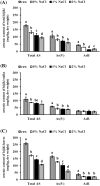Reduction of total, organic, and inorganic arsenic content in Hizikia fusiforme (Hijiki)
- PMID: 30956875
- PMCID: PMC6431341
- DOI: 10.1007/s10068-018-0501-3
Reduction of total, organic, and inorganic arsenic content in Hizikia fusiforme (Hijiki)
Abstract
This study aimed to evaluate the reduction of total, organic, and inorganic arsenic content in Hizikia fusiforme (hijiki). Initially, the six most common arsenic compounds in hijiki and its organs were evaluated, among which only arsenate and arsenobetaine were detected. Thereafter, the entire plant, including the stalk and leaves, was treated with heat and NaCl solution, individually and in combination. Heating at 90 °C for 5 min significantly reduced arsenic content in hijiki by approximately 33-80%. Treatment with NaCl solution significantly reduced arsenic content in hijiki, except for arsenobetaine content in the stalk. Combinatorial treatment further decreased arsenic content by more than 5-20%. In conclusion, consumption of hijiki after boiling at 90 °C and soaking in 2% NaCl solution reduces the intake of inorganic arsenic by consumers.
Keywords: Heating; Inorganic arsenic; Organic arsenic; Soaking; Total arsenic.
Conflict of interest statement
Compliance with ethical standardsThe authors declare that they have no conflict of interest.
Figures



Similar articles
-
Hizikia fusiformis: Pharmacological and Nutritional Properties.Foods. 2021 Jul 19;10(7):1660. doi: 10.3390/foods10071660. Foods. 2021. PMID: 34359532 Free PMC article. Review.
-
Nitric acid-based partial-digestion method for selective determination of inorganic arsenic in hijiki and application to soaked hijiki.Shokuhin Eiseigaku Zasshi. 2008 Apr;49(2):88-94. doi: 10.3358/shokueishi.49.88. Shokuhin Eiseigaku Zasshi. 2008. PMID: 18503244
-
Toxicity of so-called edible hijiki seaweed (Sargassum fusiforme) containing inorganic arsenic.Regul Toxicol Pharmacol. 2012 Jul;63(2):291-7. doi: 10.1016/j.yrtph.2012.04.006. Epub 2012 Apr 27. Regul Toxicol Pharmacol. 2012. PMID: 22561181
-
Aqueous extraction of water-soluble inorganic arsenic in marine algae for speciation analysis.Anal Sci. 2012;28(8):773-9. doi: 10.2116/analsci.28.773. Anal Sci. 2012. PMID: 22878632
-
Effect of thermal treatments on arsenic species contents in food.Food Chem Toxicol. 2008 Jan;46(1):1-8. doi: 10.1016/j.fct.2007.08.021. Epub 2007 Aug 23. Food Chem Toxicol. 2008. PMID: 17928121 Review.
Cited by
-
Hizikia fusiformis: Pharmacological and Nutritional Properties.Foods. 2021 Jul 19;10(7):1660. doi: 10.3390/foods10071660. Foods. 2021. PMID: 34359532 Free PMC article. Review.
-
Impact of thermal processing on the nutrients, phytochemicals, and metal contaminants in edible algae.Crit Rev Food Sci Nutr. 2022;62(2):508-526. doi: 10.1080/10408398.2020.1821598. Epub 2020 Sep 23. Crit Rev Food Sci Nutr. 2022. PMID: 32962399 Free PMC article.
-
Dietary exposure to heavy metals and iodine intake via consumption of seaweeds and halophytes in the European population.EFSA J. 2023 Jan 31;21(1):e07798. doi: 10.2903/j.efsa.2023.7798. eCollection 2023 Jan. EFSA J. 2023. PMID: 36742462 Free PMC article.
-
Enzymatic Hydrolysis of Orange-Footed Sea Cucumber (Cucumaria frondosa)-Effect of Different Enzymes on Protein Yield and Bioactivity.Foods. 2023 Oct 7;12(19):3685. doi: 10.3390/foods12193685. Foods. 2023. PMID: 37835338 Free PMC article.
-
Exposure to iodine, essential and non-essential trace element through seaweed consumption in humans.Sci Rep. 2024 Jun 13;14(1):13698. doi: 10.1038/s41598-024-64556-w. Sci Rep. 2024. PMID: 38871780 Free PMC article.
References
-
- Abernathy CO. Bioaccumulation of arsenic (As) in fish & toxicity of as species. Washington DC, USA: US Environmental Protection Agency; 2003.
-
- Agency for Toxic Substances and Disease Registry. Public health statement for arsenic. Available from: https://www.atsdr.cdc.gov/spl/resources/index.html. Accessed June 27, 2018
-
- Baek HI, Kim SW, Ha KC, Kim HM, So BO, Choi EK, Park EO, Jeon BJ, Park BH, Nam TJ, Kim IH, Chae SW. Effectiveness of Hizikia fusiformis extract on erosive gastritis: A4-week, randomized, double-blind and placebo-controlled trial. Int. J. Pharmacol. 2015;11(1):719–725.
LinkOut - more resources
Full Text Sources
